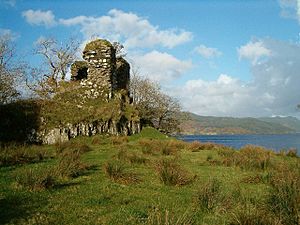Fincharn Castle facts for kids
Quick facts for kids Fincharn Castle |
|
|---|---|
| Loch Awe | |

Fincharn Castle
|
|
| Site history | |
| Built | probably about 1240 |
Fincharn Castle is an old, ruined castle found near Ford in Scotland. It sits on the southwest shore of a beautiful lake called Loch Awe. You might also hear it called Fionchairn Castle or Glassery Castle.
Contents
Fincharn Castle: A Glimpse into Scotland's Past
Fincharn Castle is a fascinating ruin that tells stories of ancient times. It stands as a reminder of the powerful people and important events that shaped Scotland centuries ago.
Building a Stronghold
This castle was likely built around the year 1240. This was the same year that the land around Fincharn was given to a person named Giolla Easbaig Mac Giolla Chríost. The gift was made by Alexander II, King of Scotland, who was the king at that time. Building a castle showed power and helped protect the land.
A Castle in Conflict
Fincharn Castle played a part in some important events in Scottish history.
The English King's Interest
In 1297, the castle seems to have been mentioned in letters between Alasdair Óg Mac Domhnaill and King Edward I of England. King Edward I was the ruler of England. In these letters, Alasdair Óg said he took control of the area and castle of "Glasrog." He took it from the "Steward of Scotland." A Steward was a very important official who managed the king's lands. Alasdair Óg claimed the Steward was not loyal to the English king. This shows how castles like Fincharn were important for controlling land and showing loyalty.
Guarding for the King
Later, around 1308 or 1309, Fincharn Castle might have been one of three castles mentioned in letters between Eóin Mac Dubhghaill and King Edward I. Eóin Mac Dubhghaill wrote that he had soldiers guarding these castles for the English king. This means Fincharn Castle was likely used to house troops and protect the king's interests during times of conflict.
Protecting History
Today, Fincharn Castle is a scheduled ancient monument. This means it is a very important historical site that is protected by law. It helps us learn about Scotland's past and how people lived and fought centuries ago.

